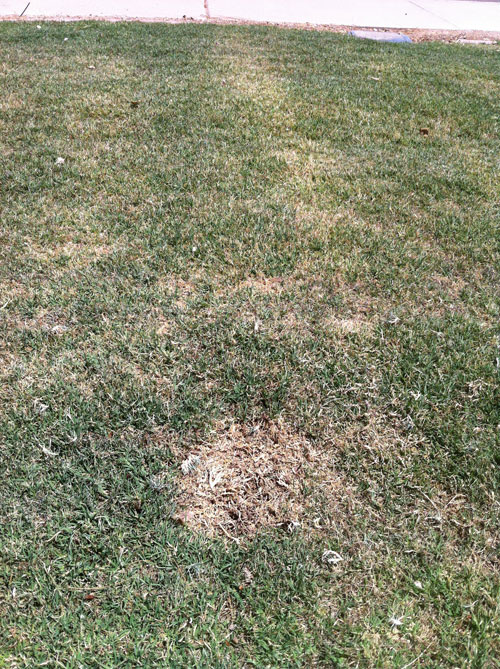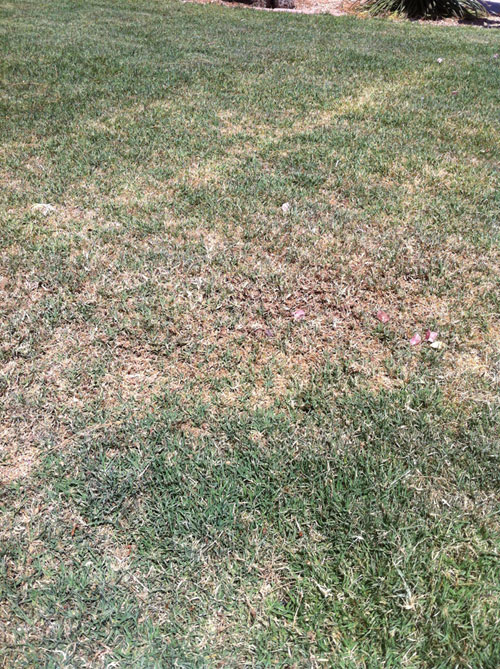Jun
Perfecting Your Summer Lawn
We are starting to approach the monsoon season and many of you are still struggling through another tough transition year. Be rest assured that at least the humidity brings grass growth. The best time of the year to see significant growth and establishment for your lawn is during the hot summer months. Most people are afraid to put a lawn down during the summer because they are scared that it will shrink up and fade away in the 115 degree temperatures, but that is actually not the case. Warm season lawns are grown optimally between 90-105 degrees and the higher temperatures don’t set it back at all. Today I’m going to give you a quick overview of what you can expect to see over the next month and how to treat different lawn issues.
The first and most important thing I can stress today is getting a good summer lawn established so you have a base for your ryegrass during the winter months. If you have no bermudagrass or paspalum, you will not have any ryegrass. Ryegrass grows extremely well when it has a protective base such as a warm season grass and when it is planted in dirt that plant will be weak and spindly. With that in mind it is very important to use the next 90 days to get your summer lawn in perfect health and ready for the winter season. I know it’s hot outside and no one wants to go out take do yard work but a little preventative work now will save you a lot of time this winter.
Many of us including myself have seen the ryegrass finally fade away in the last few areas and because of the length of time it shaded the grass it has caused a decline in your warm season grass. Remember that bermudagrasses and paspalum’s are not shade tolerant grasses and any ryegrass left on top of them are serving as the worst type of shade. So how do you get it out of there and get the lawn fixed?
1. Verticut the entire lawn now that it is actively growing and remove any of the dead material left behind. This will also help stress out any of the last remains of ryegrass. When you finish this operation you will notice some bare areas but don’t be concerned since now that the restriction between grass blades has been removed you can look for lateral growth.
2. Fill in the open areas with sand (a washed mortar sand is ok) and give the grass a level surface for the runners to grow. The runners that you see all over your sidewalks and concrete will do the same thing in bare grass areas if treated correctly.
3. Don’t be concerned about small areas during transition because the primary growth time for summer grasses will begin once we start to get some humidity. The heat is great but combine heat with humidity and we will be growing grass like Florida homeowners in no time at all.
4. Fertilize with either Soil Burst 5-15-10 @ 10 pounds/1000 SF for bermudagrass or 5 pounds per 1000 SF of paspalum this month and get the proper nutrients back in your lawn. If you have large sections of lawn to fill in or need a quick green up for a party then use 21-0-0 (ammonium sulfate) at 5 pounds per 1000 SF on bermudagrass but never use this on paspalum. This is a temporary fix and should not be solely used in lieu of proper nutrients. If you use this every month you will have all top growth and no root growth.
5. During periods of hot, dry weather you should be watering every other day for 20-25 minutes first thing in the morning and during the humid season cut it back to 20-25 minutes every 3 days because the ground will hold more moisture. Do not water every day unless you want your lawn to shrivel up and die. You should only use this approach during the initial grow in of sod.
6. Foliar feed your lawn with Soil Burst 7-7-7, 16-0-4, and 4-0-6 to maintain good leaf color and to grow good roots. I like to switch between the four Soil Burst products each month on my lawn to ensure proper nutrient balance and great lawn color. (Example: June 5-15-10, July 7-7-7, August 16-0-4, September 4-0-6, October 5-15-10 with the overseed.)
7. If you have large dead spots in your lawn that are three feet or more apart then you should cut out the area in a square and lay sod in those spots. The new sod will require you water it 3-4x a day for a month but hand watering will be fine. I say to cut it out square and larger than needed to keep the area clean and the edges nice.
8. If you’re suffering from run off or your soil is extremely compacted it is a great time to run an aerifier over the lawn. You can simply mow up the plugs when you’re finished and leave the holes open. If you aerify water every day for a week to keep the soil from drying out too quickly.
9. Give your lawn 100 days of no competition with ryegrass before you start the overseeding process this fall. In other words if you plan on seeding September 15 then your current lawn should have been 100 percent bermudagrass or paspalum by June 1st. Since you shouldn’t be seeding until mid October you have plenty of time to get your summer lawn established.
10. Remember the summer is the absolute best time to put a new lawn in and you can expect it to root down in 3-5 days. The grass will probably turn brown right after it goes down but that is because the root system has been cut off and once the grass takes hold in the ground it greens right back up.
Here is a clip of me with the Garden Guy last week talking about new varieties of sod and why the summer is the best time to plant. I will be on again with Dave the Garden Guy in couple weeks on Saturday morning.
http://www.azfamily.com/good-morning-arizona/Garden-Guy—-All-about-sod-159095825.html .

The dead spots in the lawn picture shows an area that needs to be raked up and sanded so runners can fill in the dead area.

The striping picture shows a misapplication of ammonium sulfate and how over applying or missing spots will show up in your lawn. It is always best to use safer fertilizers such as Soil Burst to help eliminate potential issues like this.
If you have any questions please feel free to email me or if you want me to look at some pictures of your lawn send them to info@westernsod.com and I will answer as soon as I can.

